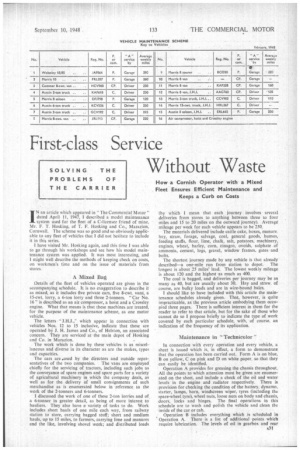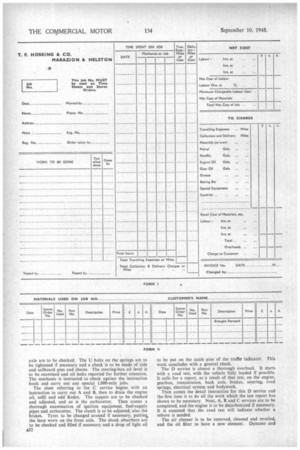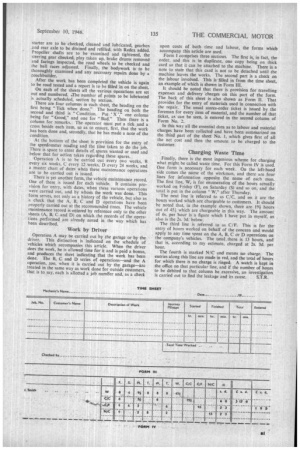First-class Service Without Waste
Page 33

Page 34

Page 35

If you've noticed an error in this article please click here to report it so we can fix it.
How a Cornish Operator with a Mixed Fleet Ensures Efficient Maintenance and Keeps a Curb on Costs
IN an ariicle which appeared in "The Commercial Motor" dated April 11, 1947, 1 described a model maintenance system used for the fleet of a C-licensee friend of mine, Mr. F. T. Hosking, of T. F. Hosking and Co., Marazion, Cornwall. The scheme was so good and so obviously applicable to any fleet of vehicles that I did not hesitate to include
it in this series. .
I have visited Mr. Hoskins again, and this time I was able to go through his workshops and see how his model maintenance system was applied. It was most interesting, and I might well describe the methods of keeping check on costs, on workmen's time and on the issue of materials from stores.
A Mixed Bag
Details of the fleet of vehicles operated are given in the accompanying schedule. It is no exaggeration to describe it as mixed, as it includes five private cars. five 8-cwt. vans, a 15-cwt. lorry, a 6-ton lorry and three 2-tonners. "Car No. 16" is described as an air compressor, a hoist and a Crossley engine. What that means is that these machines are treated, for the purpose of the maintenance scheme, as one motor vehicle.
The letters " J.H.J.," which appear in connection with vehicles Nos. 12 to 15 inclusive, indicate that these are operated by J. H. James and Co., of Helston, an associated concern. They are serviced at the main depot of Hosking and Co. in Marazion.
The work which is done by these vehicles is as miscellaneous and diverse in its character as are the makes, types and capacities.
The cars are ,used by the directors and outside representatives of the two companies. The vans are employed chiefly for the servicing of tractors, including such jobs as the conveyance of spare engines and spare parts for a variety of agricultural machinery in which the company deals, as well as for the delivery of small consignments of such merchandise as is enumerated below in reference to the work of the 2-tonners and 6-tonners.
I discussed the work of one of these 2-ton lorries and of a 6-tonner in greater detail, as being of more interest to hauliers. They also have a variety of tasks to do. Work includes short hauls of one mile each way, from railway station to store, carrying bagged stuff; short and medium hauls, up to 15 miles, to farmers, carrying lime and manures and the like, involving shovel work; and distributed loads (by which I mean that each journey involves several deliveries from stores to anything between three to four miles and 15 to 20 miles on the outward journey). Average mileage per week for each vehicle appears to be 250.
The materials delivered include cattle cake, boxes, manure hay, straw, forage, salvage, coal, general goods, humus, feeding stuffs, flour, lime, chalk, salt, potatoes, machinery, engines, wheat, barley, corn, cinagro, ovoids, sulphate of ammonia, cement, logs, gravel, window frames, gates and bolts.
The shortest journey made by any vehicle is that already described—a one-mile run from station to depot. The longest is about 25 miles' lead. The lowest weekly mileage is about 120 and the highest as much as 400.
The coal is bagged, and deliveries per journey may be as many as 40, but are usually about 10. Hay and straw of course, are bulky loads and are in wire-bound bales. should like to have included with this article the maintenance schedules already given. That, however, is quite impracticable, as the previous article embodying them occupied three pages. There is sufficient interest in them for the reader to refer to that article, but for the sake of those who cannot do so I propose briefly to indicate the type of work covered by each particular schedule, with, of course, an indication of the frequency of its application.
Maintenance in "Technicolor" In connection with every operation and every vehicle, a sheet is issued which is, in effect, a form to demonstrate that the operation has been carried out. Form A is on blue, B on yellow, C on pink and D on white paper, so that they can easily be identified.
Operation A provides for greasing the chassis throughout. All the pointsto which attention must be given are enumerated on the sheet, and include a check of the oil and water levels in the engine and radiator respectively. There is provision for checking the condition of the battery, dynamo, starter, lamps, horn, windscreen wiper, tyres (including the spare-wheel tyre), wheel nuts, loose nuts on body and chassis, doors, locks and hinges. The final operations in this schedule are to wash and polish the vehicle and clean the inside of the car or cab,
Operation B includes everything which is scheduled in
▪ Operation A. There is a list of additional points which require lubrication. The levels of oil in gearbox and rear
axle are to be checked. The U bolts on the springs are to be tightened if necessary and a check is to be made of side and tailboard pins and chains. The steering-box oil level is to be examined and oil leaks reported for further attention. The mechanic is instructed to check against the instruction book and carry out any special 1,000-mile jobs.
The sheet referring to the C service begins with an instruction to carry out A and B, then to drain the engine oil, refill and add Redex. The tappets are to be checked and adjusted, and so is the carburetter. Then comes a thorough examination of ignition equipment, fuel-supply pipes and carburetter. The clutch is to be adjusted, also the brakes. Tyres to be changed around if necessary, putting. the least worn on the front axle. The shock absorbers are to be checked and filled if necessary and a drop of light oil A32
to be put on the catch pins of the traffic indicatof% This work concludes with a general check.
The D service is almost a thorough overhaul. It starts with a road test, with the vehicle fully loaded if possible. It calls for a report, as a result of that test, on the engine, gearbox, transmission, back axle, brakes, steering, road springs, electrical system and bodywork.
Then comes the detail instruction for this D service and the first item is to do all the work which the test report has shown to be necessary. Next, A, B and C services are to be completed, and the engine is to be decarbonized if necessary. It is assumed that the road test will indicate whether a rebore is needed.
The air cleaner is to be removed, cleaned and re-oiled, and the oil filter to have a new element. Dynamo and
starter are to be checked, cleaned and lubricated, gearbox and rear axle to be drained and refilled, with Redex added. Propeller shafts are to be examined and tightened, the steering gear checked, play taken up. brake drums removed and facings inspected, the road wheels to be checked and the ball races adjusted. Finally, the bodywork is to be thoroughly examined and any necessary repairs done by a coachbuilder.
After the work has been completed the vehicle is again to be road tested and a report is to be filled in on the sheet.
On each of the sheets all the various operations are set out and numbered. ..The number of points to be lubricated is actually scheduled, section by section.
There are four columns in each sheet, the heading on the first being " Tick when done." The heading on both the second and third is " Condition. Put X '" one column being for "Good," and one for "Bad." Then the.re is a column for remarks. The operator must put a tick and a cross beside each item, so as to ensure, first, that the work has been done and, secondly, that he has made a note of the condition.
At the bottom of the sheet is provision for the entry of the speedometer reading and the time taken to do the job. There is space to enter details of spares wanted or used and below that for action taken regarding these spares.
Operation A is to be carried out every two weeks, B every six weeks, C every 12 weeks, D every 24 weeks, and a master chart of dates when these maintenance operations are to be carried out is issued.
There is yet another form, the vehicle maintenance record. One of these is issued for each vehicle. It contains provision for entry, with dates, when these various operations were carried out, and by whom the work was done. This form serves, not only as a history of the vehicle, but also as a check that the A, B, C and D operations have been properly carried out at the recommended times. The vehicle maintenance record is entered by reference only to the other sheets (A, B, C and D) on which the records of the operations performed are already noted in the way which has been described.
Work by Driver Operation A may be carried out by the garage or by the driver. This distinction is indicated on the schedule of vehicles which accompanies this article. When the driver does the work, he is allowed time for it and is paid a bonus, and produces the sheet indicating that the work has been done. The B, C and D series of operations—and the A operation, too, when it is carried out by the garage—arc treated in the same way as work done for outside customers, that is to say, each is allotted a job numlier and, as a check upon costs of both time and labour, the forms which accompany this article are used.
Form I comprises three sections. The first is, in fact, the order, and this is in duplicate, one copy being on thick card so that it can be attached to the machine. There is a note to state that this card is not to be detached until the machine leaves the works. The second part is a check on the labour involved. This is-filled in from the time sheet. an &le of which is shown in Forin
It should be noted that there is provision for travelling expenses and delivery charges on this part of the form. The back of this sheet is also shown as Form II. That provides for the entry of materials used in connection with the repair. The usual stores-order ticket is issued by the foreman for every item of material, and the number of that ticket, as can be seen, is entered in the second column of Form No. 2.
In this way all the essential data as to labour and material charges have been collected and have been summarized on the third part of the sheet No. 1, which gives first of all the net cost and then the amount to be charged to the customer.
Charging Waste Time Finally, there is the most ingenious scheme for charging what might be called waste time. For this Form IV is used. One form is necessary for each week. On the left-hand side comes the name of the workman, and there are four lines for information opposite the name of each man. The first line, W, is for enumeration of the hours actually worked on Friday (F), on Saturday (S) and so on, and the total is put in the column "W," after Thursday.
The next line is referred to as C/C, and on it are the hours Worked which are chargeable to customers. It should be noted that, in the example shown, there are 19i hours out of 451 which are chargeable in this way. The amount of 6s. per hour is a figure which I have put in myself, as also is the 2s. 3d. below.
The third line is referred to as C/F. This is for the entry of hours worked on behalf of the concern and would apply to any time spent on the A. B, C or D operations on the company's vehicles. The total there is 13 hours, and that is, according to my estimate, charged at 2s. 3d. per hour.
The fourth is marked N/C and means no charge. The entries along this line are made in red, and the total of hours for which there is no charge is ringed. A watch is kept in the office on that particular line, and if the number of hours to be debited to that column be excessive, an investigation is carried out to find the leakage and its cause. S.T.R.




















































































